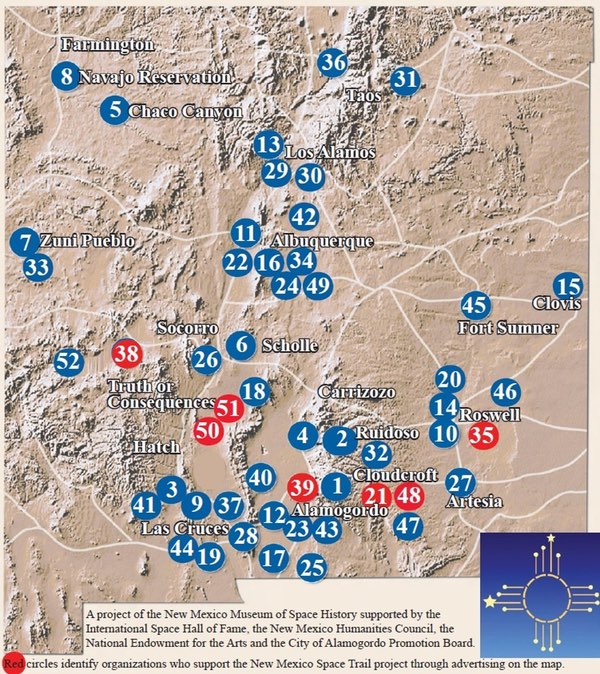
(Star) trekking the through the Land of Enchantment: the New Mexico Space Trailby Joseph T. Page II
|
| The trail exists metaphysically, but the common thread throughout is space: past, present, and future. |
What makes the sites in New Mexico unique, however, is the chronological range of activities, from archaeoastronomy in 100 BC to the upcoming planned spaceflights at Spaceport America. Moreover, these sites are linked in name and purpose, under the banner “New Mexico Space Trail” (NMST).
Space has been part of New Mexico for a millennium. But, it took the musings of George House, then Head Curator at the New Mexico Museum of Space History (NMMSH), to trail blaze the path now known as the Space Trail. While traveling across the Tularosa Basin to give a presentation, House spied a historical highway marker and wondered, “Why don’t we have markers for space history sites?” His research team, along with the marketing division of the NMMSH, began a long journey to tie together dissimilar activities stretching the bounds of the state and across centuries of human history.
The trail exists metaphysically, in that some activities do correlate logically to one other (WSMR rocket launches and Kirtland Air Force Base space research, for example), while seeming incongruent to others (Spaceport America contrasting with Chaco Canyon sky watchers.) However, the common thread throughout is space: past, present, and future.
 The map of Space Trail sites shows a wide geographic range across New Mexico. (credit: courtesy of New Mexico Museum of Space History) |
As of 2015, 52 sites currently make up the Space Trail. The earliest known activities involving archaeoastronomy took place at two locations in the Sacramento Mountains: Wizard’s Roost and Wally’s Dome. While one site was previously known to CCC crews during the Depression Era, the second site was discovered by accident and intuition, after linking its purpose to the solstice and tracing along its fixed azimuth. Other archaeoastronomy locations include Chaco Canyon in northern New Mexico and the Scholle Crab Nebula Supernova Petroglyph in central New Mexico.
Even pre-modern rocketry has origins in New Mexico. Robert Goddard launched rockets from locations near Roswell, after leaving the confines of Massachusetts. A local museum commemorates Goddard’s activities with a steel replica of the launch tower he used to launch liquid fueled rockets. Activities around White Sands Missile Range include Launch Complex 33, the site of the first V-2 launches; and Trinity site, testing ground for the world’s first atomic bomb.
Precursor research for human spaceflight took the form of balloon flights, with and without people, around New Mexico. The balloon flights from Holloman Air Force Base are stuff of legend, wrapping into the mythology (or truth, depending on who you ask!) about the “UFO” crash at Roswell. Pulling research threads on the Roswell crash will take interested parties to the International UFO Museum and Research Center. Captain Joe Kittinger’s legendary leaps from high altitude balloons took flight and ended in New Mexico. Kittinger would later return as a capsule communicator to Felix Baumgartner’s Red Bull Stratos jump, taking place at the Roswell Air Industrial Center airport in 2012.
| Some sites along the trail also hold a bit of dubiousness as to why they were included. |
Humanity’s adventure to the Moon is well represented on the NMST as well. Apollo astronauts learned the art of collecting geologic samples at sites near Valles Caldera, Zuni Salt Lake, and near Philmont Scout Ranch. The lunar explorers of Apollo 15, Dave Scott and Jim Irwin, learned how to “burn moon dust” with driving practice of their lunar rover around Taos Gorge. In a strange-but-true story of cultural preservation, the artifacts left behind on the moon are linked to New Mexico, via state’s Historic Preservation Division’s Cultural Resources Management System: a web-based inventory of state cultural sites. The linkage is furthered with a plaque at the New Mexico Museum of Space History.
While showing an impressive collection of space history, the NMST has a few drawbacks for the casual tourist wanting to venture along it. Aside from one printed book (of which I am the author), fold-out guides available at the NMMSH, and a website, the cohesiveness of the NMST as a collective experience is still lacking in great detail. Motorcyclists and RV adventurers will find neither trail maps nor narrative instructions on how to traverse this journey. A coordinated trek along the trail has not (yet) occurred, but would be considered key to providing the NMST an air of legitimacy for adventurers.
Some sites along the trail also hold a bit of dubiousness as to why they were included. Cannon Air Force Base has no direct linkage to any space history event this author could find. The “doubling-up” of Spaceport America, with inclusion of Virgin Galactic International Headquarters as well as the spaceport itself, seems more a marketing ploy than anything, in light of the spaceport’s tarnished public image. More deserving sites, such as the National Reconnaissance Office’s Aerospace Data Facility-Southwest (ADF-SW) or the former NAVSPASUR “Space Fence” site at Elephant Butte, might warrant highlighting, albeit much to the chagrin of its benefactors.
Visitors to New Mexico will cherry-pick their favorite activities and locations to see; by happenstance, a few NMST sites will be among them. The NMST will see its fullest benefit to the state’s residents when the state government sees fit to provide more resources (e.g. money and advertising) into presenting the academic and entertainment aspects of the NMST. While Spaceport America has seen the lion’s share of negative publicity for its unfulfilled promise, many other sites have already “made their bones” by assisting with astronomical research, human spaceflight support, and pure entertainment value. It is now time for New Mexico to recognize these locations and activities fully, and tie the package together neatly for tourists, students, and academics alike.